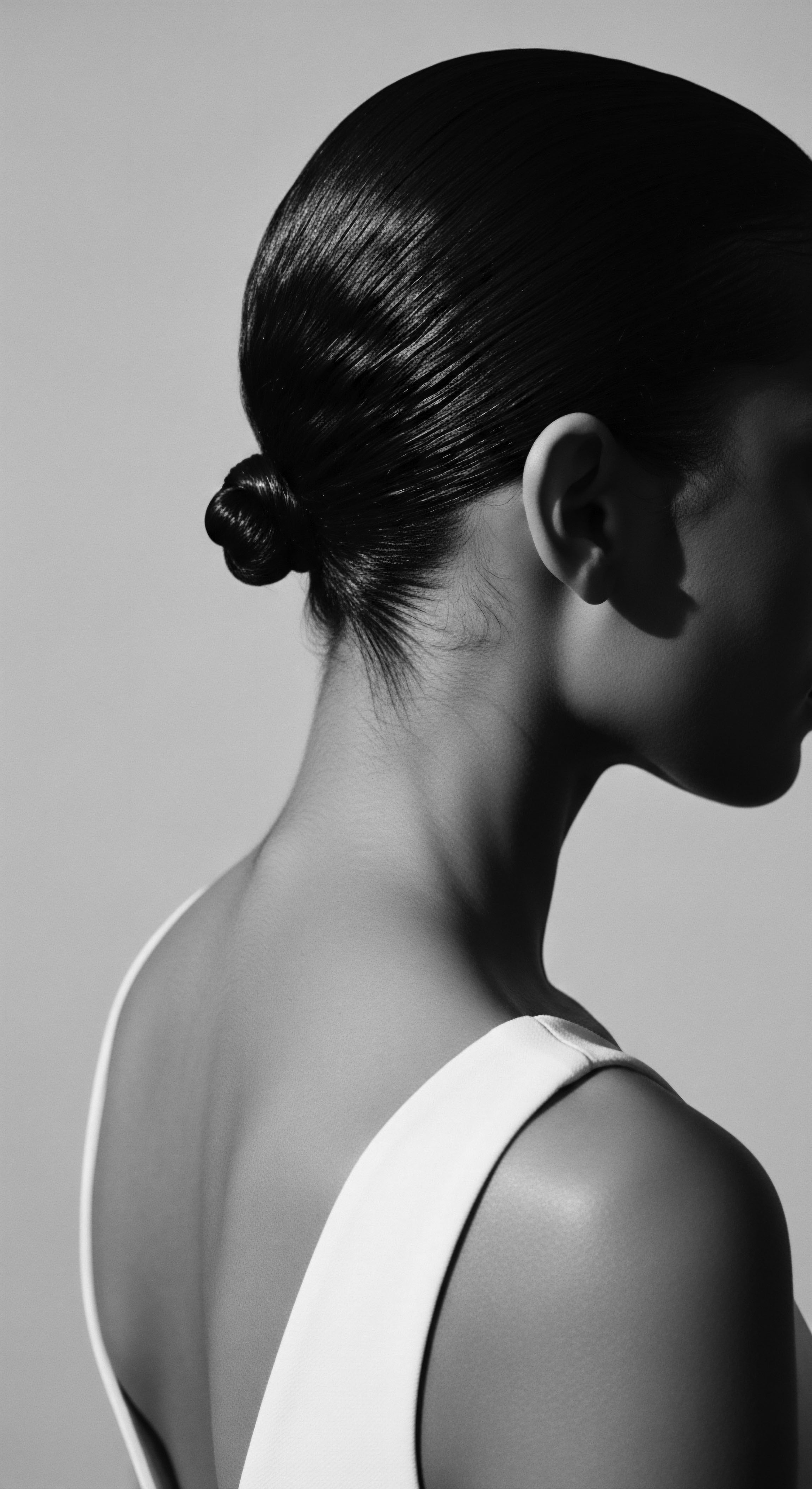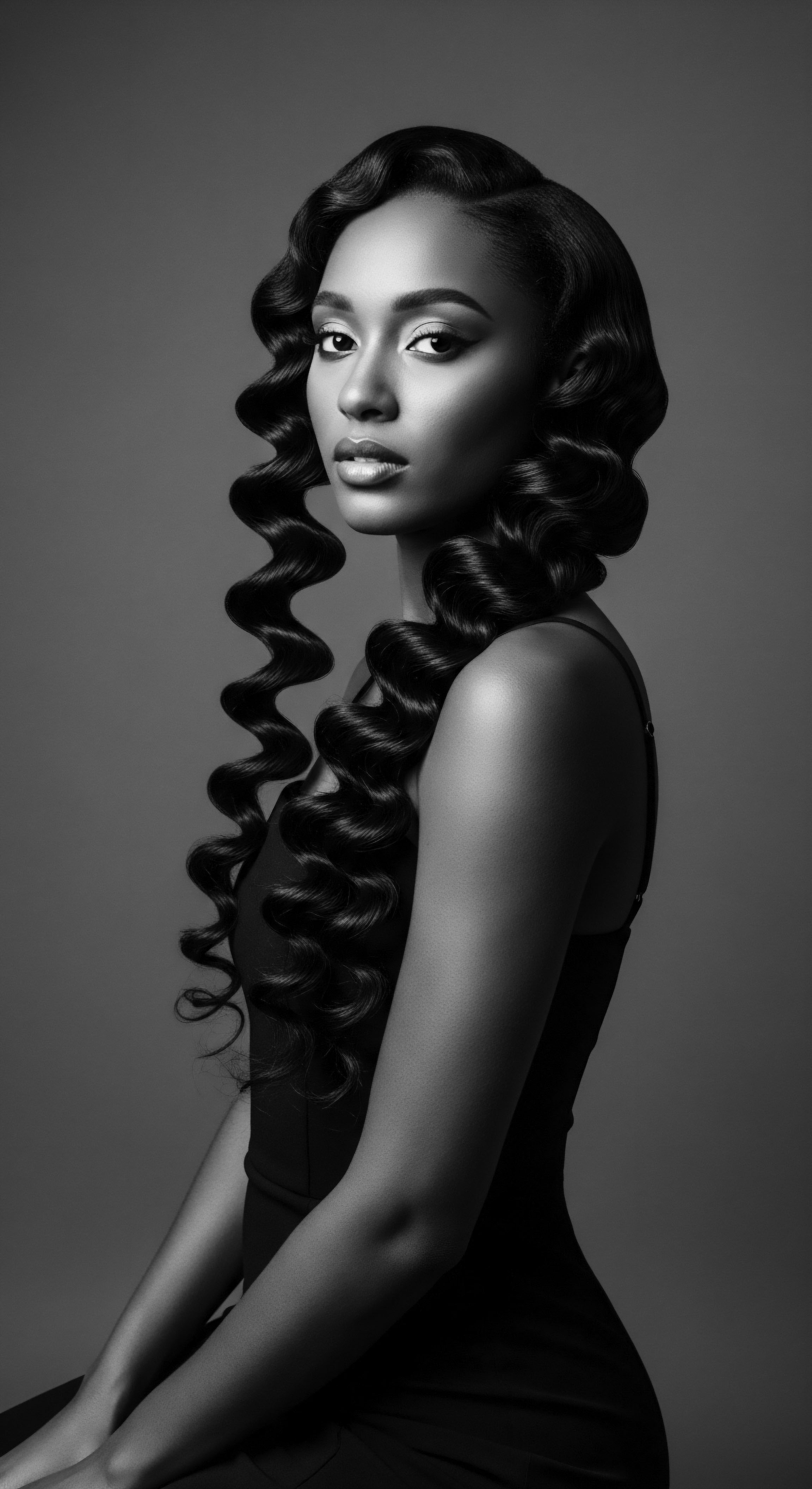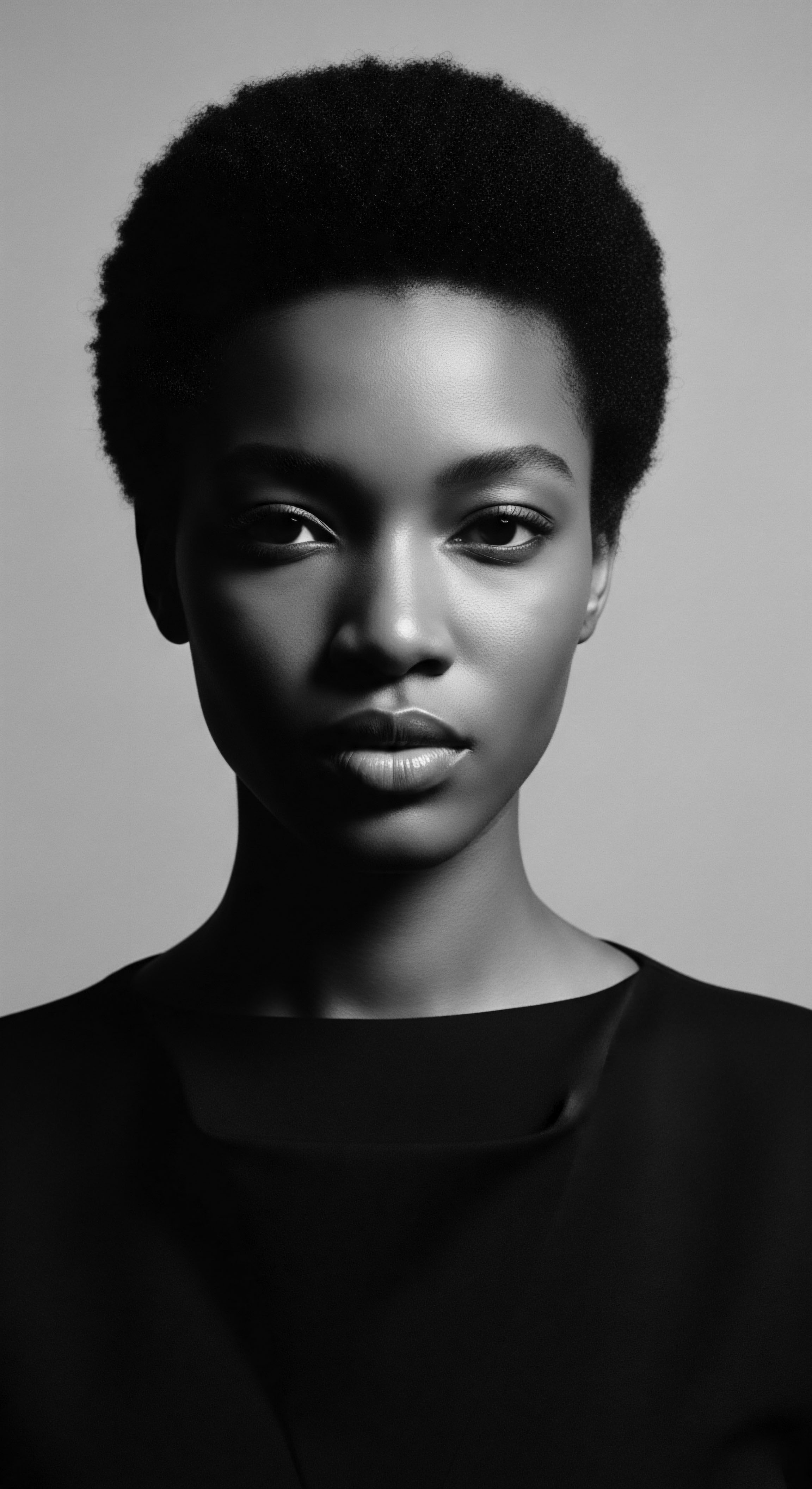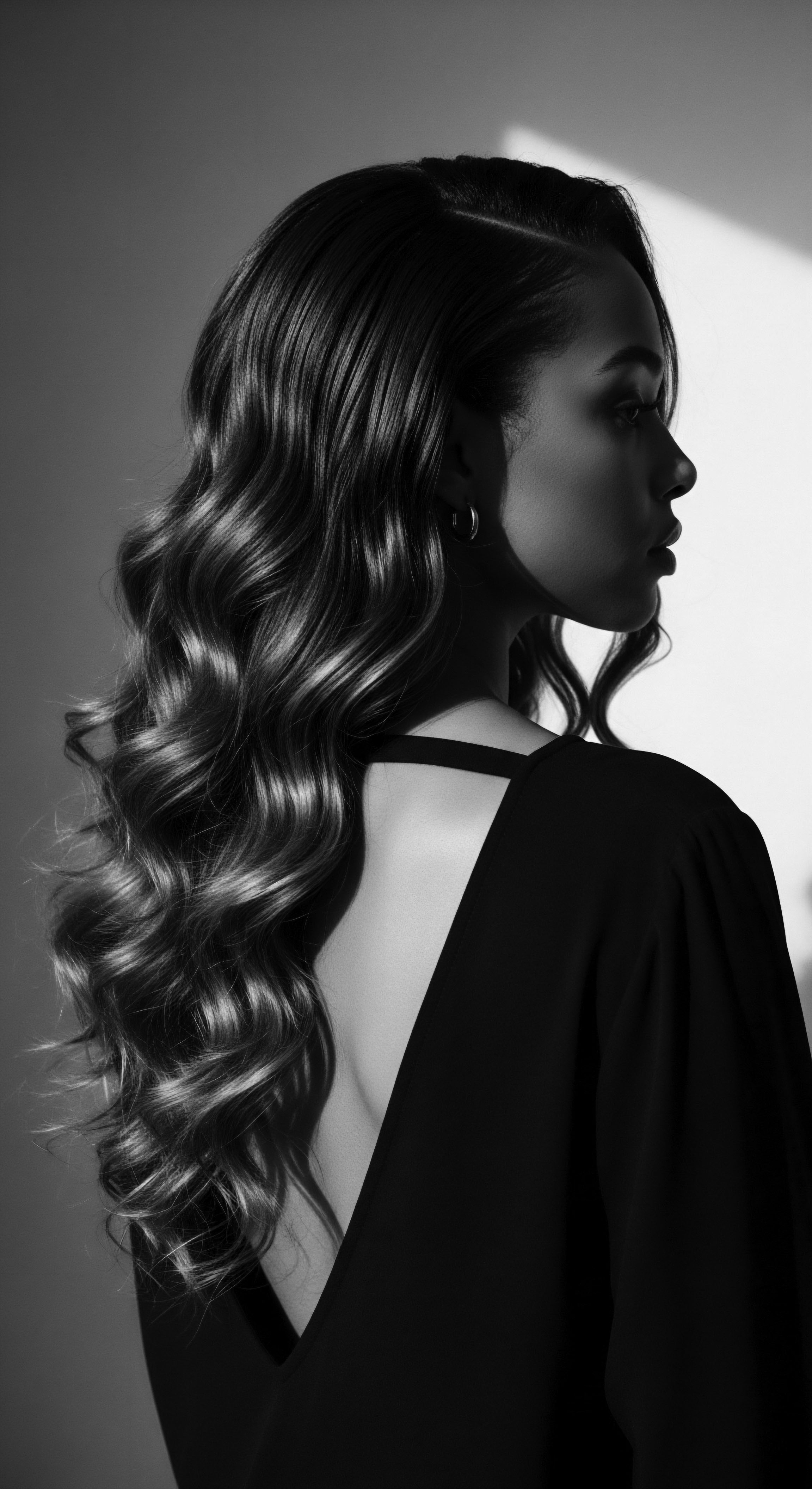
Fundamentals
The grand narrative of textured hair, for generations woven into the very fabric of identity and belonging, finds its grounding in what we might describe as the mechanisms controlling hair. This fundamental understanding begins with the hair strand itself, a living archive of our lineage, reflecting both the ancient whisperings of our biology and the gentle touch of human hands. We consider how hair, with its unique architecture, responds to manipulation, environment, and our intentional acts of care.
At its most elemental, hair is a complex protein filament, primarily composed of Keratin. This protein forms the core structure, offering both strength and flexibility. The outermost layer, the Cuticle, is comprised of overlapping scales, much like shingles on a roof. These scales, when healthy, lie flat, reflecting light and protecting the inner core.
For hair with tighter curls or coils, these cuticle scales often lift naturally at the curves, contributing to its distinct appearance and sometimes to its propensity for moisture loss. The internal structure, the Cortex, provides the hair’s tensile strength and houses the pigment that gives hair its color. Understanding these basic components provides a foundational appreciation for how different hair types interact with external forces and internal processes.
The inherent shape of a hair strand, from straight to wavy, curly, or coily, is largely determined by the shape of its follicle. Follicles producing tightly coiled strands are typically more elliptical in shape, encouraging the hair to twist and turn as it grows. This natural trajectory of growth, coupled with the distribution of keratin proteins within the strand, sets the initial parameters for how hair will behave.
The hair strand, a living archive, reveals its ancestral story through its unique architecture and inherent responsiveness to care and environment.
What then are these mechanisms for controlling hair in their simplest sense? They are the inherent and applied forces that influence hair’s form, texture, and resilience. In its most basic form, hair control centers on two key aspects:
- Intrinsic Control ❉ This refers to the hair’s natural genetic blueprint. The curl pattern, porosity, and density are inherited traits that largely dictate how hair will behave in its untouched state. This inherent characteristic is a powerful connection to our ancestral lines, a visible manifestation of our lineage.
- Extrinsic Control ❉ This encompasses all external factors and human interventions. This includes environmental elements like humidity, which causes hydrogen bonds within the hair to swell and frizz, or styling practices such as braiding, twisting, or pressing, which temporarily alter the hair’s shape.
From the earliest moments of human existence, our forebears understood these controls through observation and necessity. They witnessed how dampness affected their hair, how certain natural oils softened it, or how binding it offered protection. These simple observations led to the genesis of techniques that, though rudimentary in their scientific articulation, were deeply effective in practice. The very act of gathering hair away from the face, for instance, represents an ancient mechanism of control, offering both practical utility and the earliest stirrings of adornment.
| Mechanism Observed Moisture Absorption/Release |
| Ancestral Practice/Tool Plant oils, butters, clay masks |
| Purpose and Heritage Connection Conditioning, softening, protecting against environmental dryness, drawing from local flora. |
| Mechanism Observed Natural Curl Definition |
| Ancestral Practice/Tool Finger coiling, twisting |
| Purpose and Heritage Connection Enhancing inherent pattern, preventing tangles, a gesture of self-care and artistic expression. |
| Mechanism Observed Tension/Binding |
| Ancestral Practice/Tool Braids, knots, headwraps |
| Purpose and Heritage Connection Protecting hair from breakage, practical utility for labor, conveying status or community identity. |
| Mechanism Observed These foundational observations formed the bedrock of ancestral hair wisdom, passed down through generations. |

Intermediate
Moving beyond the elemental, a more intermediate understanding of the mechanisms controlling hair invites us to consider the intricate dance between hair’s intrinsic properties and the intentional practices applied to it. Here, the ancestral wisdom takes on a deeper hue, as we begin to see how traditional care rituals, born of necessity and deep intuitive observation, often predated modern scientific explanations for hair behavior. The true significance of Hair Control Mechanisms lies in this interplay, particularly for those with textured hair, where the genetic heritage of curl and coil presents both challenges and profound opportunities for creative expression and care.
Hair control, at this level, refers to the deliberate strategies employed to manage, style, or alter the natural state of hair, whether temporarily or permanently. This involves understanding the various types of bonds within the hair structure and how they react to different stimuli.
- Hydrogen Bonds ❉ These are temporary bonds that are easily broken by water and reformed as hair dries. They are the primary reason hair can be styled (e.g. straightened, curled) when wet and will revert to its natural pattern when re-wetted. Many traditional styling methods, from wet sets to bantu knots, manipulate these bonds.
- Disulfide Bonds ❉ These are stronger, permanent chemical bonds that contribute to the hair’s lasting shape and strength. Altering these bonds requires chemical processes, as seen in traditional straightening lyes or modern relaxers. Understanding their role is vital when considering the historical context of chemical hair alteration.
- Salt Bonds ❉ These are also temporary bonds influenced by changes in pH. Products that alter the hair’s pH, whether acidic rinses or alkaline treatments, can temporarily impact the hair’s electrical charge and thus its manageability.
The intermediate perspective reveals that Hair Control Mechanisms are not merely about imposing will upon a strand; they encompass a nuanced responsiveness. The elasticity of hair, its ability to stretch and return to its original shape, is a key mechanism. Hair with higher elasticity can withstand more manipulation, while hair with lower elasticity is more prone to breakage.
This property varies significantly among individuals and is often a focus of traditional care practices aimed at improving hair’s resilience. For example, ancestral oiling practices, using ingredients like Shea Butter or Coconut Oil, were not just about shine; they often served to coat the hair, reducing protein loss and improving elasticity by retaining moisture.
The profound wisdom of ancestral hair rituals often anticipates modern scientific understanding, revealing a continuous lineage of care and insight.
Consider the practice of Hair Threading, historically prevalent across parts of West Africa and the Caribbean, as a powerful example of an intermediate hair control mechanism. This technique involves wrapping hair tightly with thread, gently elongating the natural curl pattern without heat or chemicals.
This method showcases an intuitive understanding of hair’s physical properties. The tension from the thread temporarily stretches the hydrogen bonds within the hair, allowing for elongation and a softer, straighter appearance upon release. This traditional technique is remarkable for its non-damaging nature, providing a means of length retention and manageability without compromising the hair’s structural integrity. It stands as a testament to ancestral ingenuity, a testament to how practical observation and inherited knowledge led to sophisticated methods of care and styling.
The significance of Hair Control Mechanisms, when viewed through this intermediate lens, becomes a dialogue between the hair’s biological truths and the cultural narratives we impart upon it. It’s about respecting the hair’s natural inclination while skillfully guiding it towards desired forms, whether for ceremonial purposes, daily utility, or expressions of personal and communal identity. The intermediate level recognizes the hair’s inherent responsiveness, urging a sensitive approach that honors its delicate balance.

Academic
A rigorous academic inquiry into the mechanisms controlling hair necessitates a precise definition that extends beyond superficial manipulation to encompass the complex interplay of genetic, biophysical, and socioculturally mediated factors that govern hair fiber behavior. The hair control mechanisms represent the multifaceted, dynamic systems by which the structural integrity, morphological configuration, and cosmetic presentation of hair are influenced, maintained, or intentionally altered. This framework recognizes hair as a biological matrix responsive to internal cellular processes and external environmental and anthropogenic interventions, with particular emphasis on the distinct characteristics of textured hair. This deep examination necessitates a grounding in rigorous research, drawing from disciplines as diverse as trichology, dermatological science, material science, and cultural anthropology.
At its core, the control of hair is rooted in the Morphology of the Hair Follicle and the resulting geometry of the hair shaft. Hair control, fundamentally, pertains to the ability to manipulate the inherent curl, coil, or wave pattern; manage moisture content and prevent cuticle damage; and apply external forces to achieve desired aesthetic or protective outcomes. These mechanisms operate on several interwoven levels:
- Biophysical Control ❉ This includes the inherent properties of the hair fiber—its diameter, cross-sectional shape (circular for straight hair, elliptical for curly, highly elliptical for coily), and the uneven distribution of ortho- and para-cortical cells. These elements dictate the degree of curl and the hair’s susceptibility to environmental factors like humidity, which disrupts hydrogen bonds, leading to hygroscopic swelling and changes in fiber behavior.
- Chemical Control ❉ This involves the alteration of chemical bonds within the hair, notably Disulfide Bonds (cysteine-cysteine bridges) and hydrogen bonds. Permanent alterations, such as those achieved through relaxers or perms, involve the reductive cleavage and oxidative reformation of disulfide bonds. Temporary changes, as seen with heat styling, involve breaking and reforming hydrogen bonds, which are highly sensitive to moisture.
- Mechanical Control ❉ This refers to physical manipulation through tension, compression, and shear forces. Techniques such as braiding, twisting, wrapping, threading, and even simple combing exert mechanical control, temporarily shaping the hair by aligning fibers, creating tension, and influencing inter-fiber friction.
- Hygroscopic Control ❉ A critical, often under-examined mechanism for textured hair, this involves managing the hair’s interaction with water vapor. High porosity in some textured hair types allows for rapid absorption and desorption of moisture, causing cycles of swelling and shrinking that lead to tangling and frizz. Control here involves sealing strategies to mitigate moisture fluctuation.
The academic pursuit of understanding these mechanisms is incomplete without acknowledging the profound historical and cultural context, especially within Black and mixed-race hair experiences. Ancestral wisdom frequently developed sophisticated Hair Control Mechanisms long before modern science provided nomenclature for their underlying principles.
The true definition of hair control mechanisms emerges from the confluence of inherent biological properties, environmental influences, and profound ancestral knowledge.
Consider the historical case of hair practices among the Mbalantu Women of Namibia, a powerful illustration of Hair Control Mechanisms deeply embedded in cultural identity and longevity. The Mbalantu women are renowned for their extraordinarily long, meticulously styled hair, often reaching floor length. Their unique hair treatment, called Eembuvi, is a multi-generational practice centered on using a paste made from crushed tree bark, butter, and oils. This is not merely a cosmetic application; it represents a sophisticated Hair Control Mechanism addressing both biophysical integrity and aesthetic presentation.
The paste is applied in stages, sometimes over years, forming dense, rope-like dreadlocks. This traditional practice serves several functions:
- Mechanical Protection ❉ The thick, applied paste and the formation of dreadlocks provide a protective sheath against environmental damage, reducing breakage from friction and UV exposure, particularly crucial in arid climates.
- Moisture Retention ❉ The fatty components of the butter and oils in the Eembuvi mixture act as occlusives, sealing moisture into the hair shaft, mitigating the effects of arid air on hygroscopic properties.
- Tensile Strength and Elongation ❉ The method of application and continuous binding inherently manages the hair’s tensile properties, promoting elongation and preventing shrinkage, which can be significant in tightly coiled hair. This prolonged tension over time, coupled with the protective coating, allows for remarkable length retention that defies typical breakage rates for untreated hair.
A study by the Namibian University of Science and Technology, while not providing a specific statistic on reduced breakage for the Eembuvi method, does describe the “exceptional Preservation” and length achieved by Mbalantu hair, contrasting it with the general fragility of highly coily hair types when left unprotected (Shivolo & Nakashole, 2021). This implicit evidence of advanced hair preservation through traditional means highlights an ancestral Hair Control Mechanism achieving outcomes that modern hair science often struggles to replicate without synthetic polymers or harsh chemicals. It stands as a testament to indigenous material science and its application in hair care.
The Mbalantu practice demonstrates a sophisticated, community-bound understanding of Hair Control Mechanisms that leverages natural materials and consistent, patient application to achieve specific, long-term hair goals. It is a powerful example of how Hair Control Mechanisms extend beyond temporary styling to encompass a philosophy of hair preservation, cultural continuity, and identity formation. The very weight and form of the Eembuvi dreadlocks are integral to the Mbalantu woman’s identity, symbolizing maturity, social status, and marital state.
| Mechanism Aspect Primary Goal |
| Traditional Mbalantu Eembuvi (Ancestral Practice) Long-term preservation, cultural identity, aesthetic elongation. |
| Modern Hair Control Analogues (Contemporary Science) Temporary styling, damage repair, manageability, growth promotion. |
| Mechanism Aspect Key Agents |
| Traditional Mbalantu Eembuvi (Ancestral Practice) Crushed tree bark (e.g. Omutyuula), butter, oils, natural pigments. |
| Modern Hair Control Analogues (Contemporary Science) Silicones, polymers, heat protectants, protein treatments, chemical relaxers. |
| Mechanism Aspect Application Method |
| Traditional Mbalantu Eembuvi (Ancestral Practice) Slow, cumulative layering of natural paste over years, forming dreadlocks. |
| Modern Hair Control Analogues (Contemporary Science) Rapid application of products, immediate heat styling, chemical processing in single sessions. |
| Mechanism Aspect Underlying Principle |
| Traditional Mbalantu Eembuvi (Ancestral Practice) Continuous physical encapsulation and lipid-based moisture sealing, gentle mechanical tension. |
| Modern Hair Control Analogues (Contemporary Science) Surface coating for smoothness, temporary bond alteration, or permanent chemical bond cleavage. |
| Mechanism Aspect This comparison underscores the profound ingenuity of ancestral Hair Control Mechanisms, often prioritizing holistic preservation and cultural meaning. |
This academic lens reveals that Hair Control Mechanisms are not static concepts but are shaped by environmental pressures, available resources, and deeply held cultural values. The practices developed within Black and mixed-race communities for managing textured hair are not simply cosmetic; they represent ingenious adaptations to inherent hair properties, often in the face of societal pressures. These historical methods are vital data points, providing empirical evidence of effective hair management strategies that warrant continued scholarly attention and respect. The enduring presence of these ancestral Hair Control Mechanisms speaks to their efficacy and their intrinsic link to human expression and survival.

Reflection on the Heritage of Hair Control Mechanisms
The journey through the intricate world of hair control mechanisms, from the elemental whisperings of a single strand to the complex symphony of inherited wisdom and scientific understanding, leaves us with a profound realization ❉ hair is a living legacy. For Black and mixed-race individuals, the very act of caring for one’s hair is often a conscious or unconscious re-connection with generations past, a dialogue with ancestral hands that shaped and honored textured coils and curls long before modern innovations. The mechanisms we discuss are not abstract concepts; they are the tender threads that bind us to our lineage, the very substance of our resilience and creativity.
The heritage of hair care, far from being a mere historical footnote, remains a vibrant, pulsing current in our contemporary lives. Whether we consciously braid, twist, oil, or wrap, we are performing acts that echo through time, carrying the wisdom of those who navigated the elements and the social landscape with ingenuity and grace. The strength of the hair follicle, the elasticity of the strand, the way moisture dances with our coils – these are not just biological facts. They are invitations to understand and celebrate the unique genetic inheritance that shapes our crowns.
In an ever-changing world, where definitions and identities often feel fluid, our hair stands as a tangible link to a deep and abiding past. It serves as a reminder that the Hair Control Mechanisms, in their broadest sense, are about more than just manipulating appearance. They are about preservation—not just of length or style, but of history, of identity, of spirit.
Each choice we make in our hair care, from selecting ingredients that resonate with ancestral botanicals to adopting styles that speak to our cultural origins, contributes to this ongoing narrative. Our hair, truly, becomes an unbound helix, carrying forward the stories of our forebears, while simultaneously charting a course for future generations to follow, all imbued with the deep resonance of heritage.

References
- Byrd, A. S. (2001). Hair Story ❉ Untangling the Roots of Black Hair in America. St. Martin’s Press.
- Mercer, K. (1994). Welcome to the Jungle ❉ New Positions in Cultural and Ethnic Studies. Routledge.
- Banks, I. (2000). Hair Matters ❉ Beauty, Power, and Black Women’s Consciousness. New York University Press.
- Jackson, R. L. (2001). The House That Race Built ❉ Original Essays by Toni Morrison, Angela Y. Davis, Cornel West, and Others on Black Americans and Issues that Divide Us. Vintage.
- Craig, M. L. (2002). Ain’t I a Beauty Queen? ❉ Black Women, Beauty, and the Politics of Race. Oxford University Press.
- Tharps, L. L. & Callender, A. (2014). Hair Story ❉ Untangling the Roots of Black Hair in America. St. Martin’s Griffin.
- Roberts, K. A. (2020). The Science of Black Hair ❉ A Comprehensive Guide to Textured Hair Care. KL Roberts Enterprises.
- Shivolo, E. L. & Nakashole, L. N. (2021). The Eembuvi Hair Care Practice of Mbalantu Women in Northern Namibia ❉ An Indigenous Knowledge System. Journal of Indigenous Social Development.
- Davis, A. Y. (1981). Women, Race & Class. Vintage Books.
- Walker, A. (1993). The Temple of My Familiar. Harvest Books.
